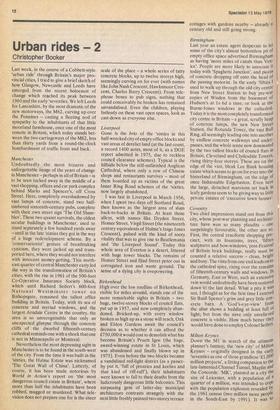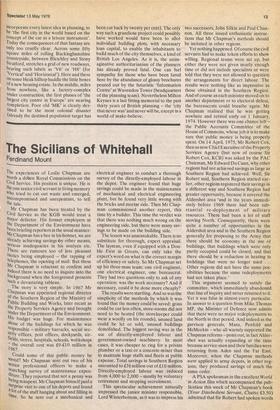Urban rides -2
Christopher Booker
Last week, in the course of a Cobbett-style 'urban ride' through Britain's major provincial cities, I tried to give a brief sketch of how Glasgow, Newcastle and Leeds have emerged from the recent holocaust of change which reached its peak between 1960 and the early 'seventies. We left Leeds for Lancashire, by the most dramatic Of the new motorways, the M62, curving up over the Pennines — casting a fleeting nod of sympathy to the inhabitants of that little moorland farmhouse, once one of the most remote in Britain, which today stands between the two carriageways of the M62, less than thirty yards from a round-the-clock bombardment of traffic front and back.
Manchester
Undoubtedly the most bizarre and unforgettable image of the years of change in Manchester — perhaps in all of Britain — is to be seen tucked away in the middle of a vast shopping, offices and car park complex behind Marks and Spencer's, off Cross Street. Here, completely overshadowed by vast lumps of concrete, stand two halftimbered sixteenth-century pubs, complete with their own street sign 'The Old Shambles'. These two quaint survivals, the oldest secular buildings in Manchester, used to stand separately a few hundred yards away — until in the late 'sixties they got in the way of a huge redevelopment scheme. By a 'conservationist' gesture of breathtaking cynicism, they were jacked up and transported here, where they would not interfere with innocent money-getting. This northeast quarter of central Manchester early led the way in the transformation of Britain's cities, with the rise in 1961 of the 500-foot Co-Operative Insurance Society block, which until Richard Seifert's 600-foot National Westminster tower on Bishopsgate, remained the tallest office building in Britain. Today, with its sea of concrete and myriad windows, 1.nd the largest Arndale Centre in the country, the area is so unrecognisable that only an unexpected glimpse through the concrete cliffs of the dwarfed fifteenth-century cathedral reminds one with a shock that one is not in Minneapolis or Montreal.
Nevertheless the most depressing sight in Manchester is to be found in the south-west of the city. From the time it was built in the
'sixties, the Hulme Estate was nicknamed The Great Wall of China'. Latterly, of course, it has been 'made notorious by
World in Action's report on 'the most dangerous council estate in Britain', where
more than half the inhabitants have been robbed, mugged or murdered. What television does not prepare one for is the sheer scale of the place — a whole series of tatty concrete blocks, up to twelve storeys high, seemingly curving on for ever (with names like John Nash Crescent, Hawksmoor Crescent, Charles Barry Crescent). From telephone boxes to pub signs, nothing that could conceivably be broken has remained unvandalised. Even the children, playing listlessly on these vast open spaces, look as cast-down as everyone else.
Liverpool
Gone is the brio of the 'sixties in this half-wrecked city of empty office blocks and vast areas of derelict land (at the last count, a record 1400 acres, most of it, as a DOE report admitted in 1975, due to reckless council clearance schemes). Typical is the hillside below the still-unfinished Anglican Cathedral, where only a row of Chinese shops and restaurants survives — most of them boarded up as victims of the great Inner Ring Road schemes of the 'sixties, now largely abandoned.
I was last in Liverpool in March 1956, when I spent two days off Scotland Road, then known as the largest area of slum back-to-backs in Britain. At least those alleys, with names like Dryden Street, Homer Street, Virgil Street (the nineteenth century equivalents of Hulme's Inigo Jones Crescent), pulsed with the kind of sooty vitality that was to give rise to Beatlemania and 'the Liverpool Sound'. Today this whole area of Everton is a desert, littered with huge tower blocks. The remains of Homer Street and Iliad Street peter out in corrugated iron and waste ground. The sense of a dying city is ovepowering.
Birkenhead
High over the low roofline of Birkenhead, visible for miles around, stands one of the more remarkable sights in Britain — two huge, twelve-storey blocks of council flats, put up in 1957, and now completely abandoned. Bricked-up, with every window broken as high up as a stone will reach, Oak and Eldon Gardens await the council's decision as to whether it can afford the £750,000 it would cost to demolish what has become Britain's Pruett Igoe (the huge, award-winning estate in St Louis,. which was abandoned and finally blown up in 1975). Even before the two blocks became a vandalised red-light district (as a passer by put it, 'full of prozzies and keelies and that kind of riff-raff), their inhabitants were known to fall to their deaths from the ludicrously dangerous little balconies. This surpassing gem of latter-day municipal architecture contrasts strangely with the neat little freshly painted two-storey terrace cottages with gardens nearby — already a century old and still going strong.
Birmingham
Last year an estate agent desperate to let some of the city's almost bottomless pit of empty office space advertised Birmingham as having 'more miles of canals than Venice'. People are more likely to associate It today with 'Spaghetti Junction', and pieces of concrete dropping off onto the head of the passing motorist. In the early 'fifties I used to walk up through the old city centre from New Street Station to buy pre-war copies of Wisden from the basement of Hudson's at is 6d a time, or look at the Burne-Jones windows in the cathedral. Today it is the most completely transformed city centre in Britain —a great, scruffy heap of concrete lumps, the new New Street Station, the Rotunda Tower, the vast Bull Ring, all seemingly leading one into another by endless concrete walkways and underpasses, and the whole scene now dominated by the two tallest blocks of council flats in Britain, Cleveland and Clydesdale Towers, rising thirty-four storeys. These are on the edge of the vast, bleak Lee Bank housing estate which seems to go on for ever into the hinterland of Birmingham, on the edge of once fashionable Edgebaston. Even here the large, detached mansions set back m leafy gardens seem to be giving way to little private estates of 'executive town houses •
Coventry
Two chief impressions stand out from this city, whose post-war planning and architecture have won so many plaudits — one surprisingly favourable, the other not so. First, the central cruciform shopping precinct, with its fountains, trees, 'fifties sculptures and bow-windows, 'post-Festival of Britain brick buildings, really must be counted a relative success — clean, bright and busy. The vista from one end leads on to the cathedral spire, rising over the remains of fifteenth-century walls and windows. fa Germany, East or West, such an extensive ruin would undoubtedly have been restored down to the last detail. What a pity it was not, I thought as for the first time I entered Sir Basil Spence's grim and grey little concrete barn. A 'God's-eye-view' froul the altar shows a building at least full of light; but from the nave only unrelieved concrete is visible. How much better theY would have done to employ Colonel Seifert.
Milton Keynes
Down the M1 in search of the ultimate planner's fantasy, the 'new city' of Milton Keynes — originally designed in the earlY 'seventies as one of those grandiose '£1,000 million projects', a fitting companion to the late-lamented Channel Tunnel, Maplin and the Concorde. 'MK', planned as a city the size of Leicester, with a population of a quarter of a million, was intended to cope with the population explosion revealed bY the 1961 census (two million more people in the South-East by 1991). It was to incorporate every latest idea in planning, to be 'the first city in the world based on the concept of the car as a leisure instrument'. Today the consequences of that fantasy are only too cruelly clear. Across some fifty square miles of rolling Buckinghamshire countryside, between Bletchley and Stony Stratford, stretches a grid of new roadways, bearing such labels as `V69 or 'HS' (for Vertical' and 'Horizontal'). Here and there on some bleak hilltop huddle the little boxes of a new housing estate. In the middle, miles from nowhere, like a factory-complex under construction, the first phases of 'the largest city centre in Europe' are nearing Completion. Poor old 'MK' is clearly destined to be the most colossal disaster (already the destined population target has
been cut back by twenty per cent). The only way such a grandiose project could possibly have worked would have been to allot individual building plots, with necessary loan capital, to enable the inhabitants to build much of the city themselves, a kind of British Los Angeles. As it is, the unimaginative authoritarianism of the planners has already proved fatal. One can feel sympathy for those who have been lured here by the abundance of glossy brochures poured out by the futuristic 'Information Centre' at Wavendon Tower (headquarters of the planning team). Nevertheless Milton Keynes is a last fitting memorial to the past thirty years of British planning — the 'city that never was' and never will be, except in a world of make-believe.



































 Previous page
Previous page